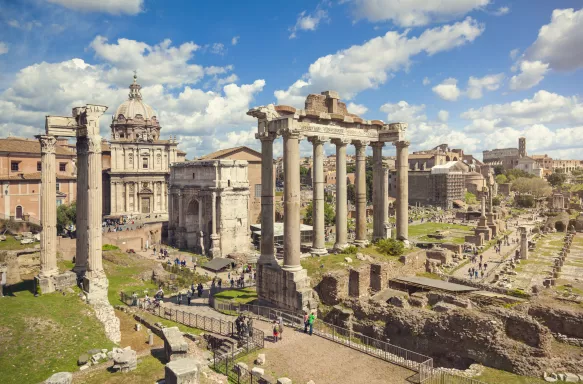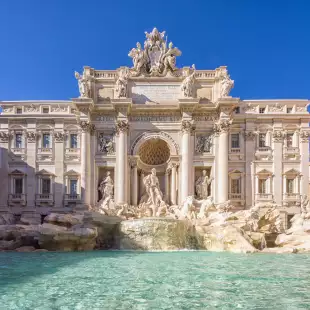4 Must-See Sights in Rome

Find out our top four recommendations for sightseeing in Rome.
by Becky, Operations Team
Rome, a city of ancient and magnificent structures that span thousands of years, numerous empires, dynasties and papacies, an enthralling city of long-lost riches and shadows of majesty. Today that grandeur is echoed in the exquisite Baroque and Renaissance architecture that stands firm amongst the remnants of this ancient city’s landscape.
Whether you choose to explore the city on our short break to Rome or our Classical Italy tour, we will make sure that you always gain the best possible experience of your surroundings and its history. During our Rome city break, you will have the chance to discover its Baroque past through the legendary monuments of the period including the Trevi fountain, the Piazza Navona and the Piazza di Spagna; home to the poet and writer Keats, and the popular haunt of writers Shelley, Milton and Byron. You will also delve into the vast and wildly impressive history of the Roman empire with a trip to the Colosseum, Circus Maximus and Palatine Hill.
Whilst your Classical Italy tour will take you on a wider journey, giving you the opportunity to enjoy the splendour of the ancient cities of Siena, Florence, Arezzo and Assisi before we make our way to Rome and explore this captivating capital.
1. Vatican City
During your first morning in Rome we will guide you round Rome’s principle sights and monuments including St. Peter’s Basilica, the Colosseum, Circo Massimo, Victor Emmanuel memorial, the Vatican, Palatine Hill, the River Tiber and more. After which, the afternoon is your own to venture where you choose.
Take in more of Vatican City and the surrounding area starting at the Vatican Museum; this wildly impressive building is full of some of the world’s most treasured artefacts from the last two and a half millennia. The museum is the only area of the Palace that visitors can enjoy independently, though you may consider hiring an audio guide as you make your way around the building, particularly as you head into the spectacular Sistine Chapel.
It is worth noting that one can easily spend an entire day absorbing all there is to see in the Vatican Museum, so if you are planning on seeing more during the afternoon you will need to keep a keen eye on the time. Once you have completed the tour and emerged through the Sistine Chapel, you will find yourself at the entrance of St. Peter’s Basilica, the next stop on your top places to visit in Rome.
Leaving St. Peter’s and walking up Via della Conciliazione, you will see Castel Sant ‘Angelo at the foot of the river and surrounded by ornate bridges adorned with huge Renaissance era angels, that guard the entrance to Hadrian’s Mausoleum. If you do not have time to head inside the Castel itself, take a few minutes to stand outside this towering castle that was commissioned by the Roman Emperor Hadrian in 123 AD, and has in the years since been used as a fortress, prison and castle for a number of popes.
2. The Colosseum And Palatine Hill
The seventh day of your Classical Italy tour is entirely yours, to pack as much or as little of Rome into a day as you desire. From your centrally located hotel you will be an easy distance from transport links, and on to many of the city’s main points of interest including The Colosseum and Palatine Hill.
It is wise to decide at this point which of these sites you wish to see in detail, as one could easily spend a two to three hours touring the Colosseum and longer still making your way around the vast expanse of the breathtaking Palatine Hill.
If you would prefer to stay on the go and are more inclined to see the spectacular views of Rome from Palatine Hill, walk around the left hand side of Colosseum taking in the detail of the structure as you go, past the Arch de Constantine and up towards the entrance of Palatine Hill. If you are taking this trip around lunch time this is the ideal place to stop for a picnic at one of the Hill’s various vantage points; this should take you around two to three hours.

3. Piazza Venezia
From The Colosseum, stroll down Via dei Fori Imperali to the central hub of Rome, Piazza Venezia. This piazza is forever bustling with hundreds of tourists and locals alike, and at its centre stands the unmissable, controversial structure, the Monumento Nazionale a Vittorio Emanuele II (Victor Emanuel Memorial). Built in honour of the first king of unified Italy, Victor Emmanuel in 1925, some years after construction began in 1885 and located at the edge of Capitoline Hill, the monument is regarded as pompous and overly large by many citizens. The erection of the Victor Emanuel Memorial upset many of Italy’s residence, as it entailed not only the destruction of a large area of Capitoline Hill but a Medieval neighbourhood.
On the other side of the Piazza, you will be transported back to the city’s ancient roots at Trajan’s Forum. The site was the last of the Imperial fora to be constructed in 106 AD, and today visitors can still see much of where these magnificent structures stood. Most spectacularly, Trajan’s Column built in 113 AD, is almost entirely intact. Put yourself in an ancient Roman’s sandals and enjoy a view of the forum from its base, looking across to Capitoline Hill and with a look to the left you can glimpse the Colosseum at the top of Via dei Fori Imperali.
4. Trevi Fountain And The Spanish Steps
If you are feeling ambitious by this point in the afternoon, it is possible to walk from Piazza Venezia to the Trevi Fountain. Simply stay on the Via del Fiori Imperali, walking towards Via Cesare Battisti, turn right and then left on to Via Della Pilotta, at the end of which you will be met by the thunderous sounds of the famous Trevi Fountain. Once you have arrived, make your way down the crowded steps to the front of the fountain, turn around to face the steps and toss a penny in for luck; it is said that doing so will ensure that one day you will return to Rome.
From the Trevi Fountain you are a 10 minute stroll from The Spanish Steps and the plush boutiques that surround the perfectly Italian Piazza di Spagna. It is a must to walk up the 18th century Spanish Steps that were once the haunt of Byron, Keats and Shelley, followed by a relaxing drink in a nearby bar, or even afternoon tea at Babington’s Tea Rooms, located at the bottom left of the steps – the perfect way to round up a deliciously Roman day.

If this has inspired you to consider tours to Italy or holidays to Italy, we would recommend trying Rome: Ancient & Baroque, Classical Italy, or Classical Italy for Solo Travellers . If you have any questions, please do not hesitate to contact us.









